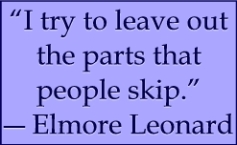There are countless articles out there on the importance of showing instead of telling. I’m going to focus on the opposite, when to tell.
What is showing and telling? Showing is conversations and getting inside the mind of the character, experiencing things as they do. Telling is shorter, because it is just stating what happened.
When I’m reading if something isn't interesting, I find my eyes glazing over and I’m off in daydream world. I don’t want to do this to my readers, so when writing I ask myself, Is this important? Will my readers feel cheated if I leave this out? If the answer is no, I tell it instead of showing everything.
Skip to the action, and skip the pleasantries.
I tell about everyday interactions and anything a character does repeatedly whenever I can. The character can be bored, but that doesn't mean the reader has to be. I tell what a character sees, especially when they are passing through an unimportant town or stopping at a restaurant. This way I go straight to the interesting parts. If something important is going to happen during the everyday stuff, I start right before the action.
I show things to make my readers feel like they are a part of the story and to let them figure things out for themselves, but it’s important that I don’t bore them with stuff they don’t care about.
Which parts do think should be told instead of shown?


No comments:
Post a Comment